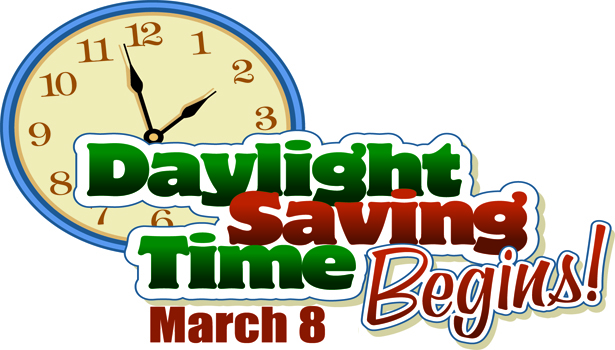COUNTY LIFE
History Channel points to 8 things you may not know about Daylight Saving Time

1. It’s “daylight saving time,” not “daylight savings time.”
Many people render the term’s second word in its plural form. However,
since the word “saving” acts as part of an adjective rather than a verb,
the singular is grammatically correct.
2. Though in favor of maximizing daylight waking hours, Benjamin Franklin did not originate the idea of moving clocks forward.
By the time he was a 78-year-old American envoy in Paris in 1784, the man who espoused the virtues of “early to bed and early to rise” was not practicing what he preached. After being unpleasantly stirred from sleep at 6 a.m. by the summer sun, the founding father penned a satirical essay in which he calculated that Parisians, simply by waking up at dawn, could save the modern-day equivalent of $200 million through “the economy of using sunshine instead of candles.” As a result of this essay, Franklin is often erroneously given the honor of “inventing” daylight saving time, but he only proposed a change in sleep schedules—not the time itself.
3. Englishman William Willett led the first campaign to implement daylight saving time.
While on an early-morning horseback ride around the desolate outskirts of London in 1905, Willett had an epiphany that the United Kingdom should move its clocks forward by 80 minutes between April and October so that more people could enjoy the plentiful sunlight. The Englishman published the 1907 brochure “The Waste of Daylight” and spent much of his personal fortune evangelizing with missionary zeal for the adoption of “summertime.” Year after year, however, the British Parliament stymied the measure, and Willett died in 1915 at age 58 without ever seeing his idea come to fruition.
4. Germany was the first country to enact daylight saving time.
It took World War I for Willett’s dream to come true, but on April 30,
1916, Germany embraced daylight saving time to conserve electricity. (He
may have been horrified to learn that Britain’s wartime enemy followed
his recommendations before his homeland.) Weeks later, the United
Kingdom followed suit and introduced “summer time.”
5. Daylight saving time in the United States was not intended to benefit farmers, as many people think.
Contrary to popular belief, American farmers did not lobby for daylight
saving to have more time to work in the fields; in fact, the agriculture
industry was deeply opposed to the time switch when it was first
implemented on March 31, 1918, as a wartime measure. The sun, not the
clock, dictated farmers’ schedules, so daylight saving was very
disruptive. Farmers had to wait an extra hour for dew to evaporate to
harvest hay, hired hands worked less since they still left at the same
time for dinner and cows weren’t ready to be milked an hour earlier to
meet shipping schedules. Agrarian interests led the fight for the 1919
repeal of national daylight saving time, which passed after Congress
voted to override President Woodrow Wilson’s veto. Rather than rural
interests, it has been urban entities such as retail outlets and
recreational businesses that have championed daylight saving over the
decades.
6. For decades, daylight saving in the United States was a confounding patchwork of local practices.
After the national repeal in 1919, some states and cities, including New
York City and Chicago, continued to shift their clocks. National
daylight saving time returned during World War II, but after its repeal
three weeks after war’s end the confusing hodgepodge resumed. States and
localities could start and end daylight saving whenever they pleased, a
system that Time magazine (an aptly named source) described in 1963 as
“a chaos of clocks.” In 1965 there were 23 different pairs of start and
end dates in Iowa alone, and St. Paul, Minnesota, even began daylight
saving two weeks before its twin city, Minneapolis. Passengers on a
35-mile bus ride from Steubenville, Ohio, to Moundsville, West Virginia,
passed through seven time changes. Order finally came in 1966 with the
enactment of the Uniform Time Act, which standardized daylight saving
time from the last Sunday in April to the last Sunday in October,
although states had the option of remaining on standard time year-round.
7. Not everyone in the United States springs forward and falls back.
Hawaii and Arizona—with the exception of the state’s Navajo Nation—do
not observe daylight saving time, and the U.S. territories of American
Samoa, Guam, Puerto Rico, the Virgin Islands and the Northern Mariana
Islands also remain on standard time year-round. Some Amish communities
also choose not to participate in daylight saving time. (Around the
world, only about one-quarter of the world’s population, in
approximately 70 countries, observe daylight saving. Since their
daylight hours don’t vary much from season to season, countries closer
to the equator have little need to deviate from standard time.)
8. Evidence does not conclusively point to energy conservation as a result of daylight saving.
Dating back to Willett, daylight saving advocates have touted energy
conservation as an economic benefit. A U.S. Department of Transportation
study in the 1970s concluded that total electricity savings associated
with daylight saving time amounted to about 1 percent in the spring and
fall months. As air conditioning has become more widespread, however,
more recent studies have found that cost savings on lighting are more
than offset by greater cooling expenses. University of California Santa
Barbara economists calculated that Indiana’s move to statewide daylight
saving time in 2006 led to a 1-percent rise in residential electricity
use through additional demand for air conditioning on summer evenings
and heating in early spring and late fall mornings. Some also argue that
increased recreational activity during daylight saving results in
greater gasoline consumption.
COUNTY LIFE
JBD Bass Tournament postponed

Due to high lake levels at Lake Amon G. Carter, the Jim Bowie Days Association organizers announced Friday the tournament has been postponed and a new date will be named soon.
COUNTY LIFE
AgriLife Extension hosting preserving the harvest workshop

Texas AgriLife Extension will host a July workshop on July 26, Preserving the Harvest, from 10 a.m. to 5 p.m. at the United Presbyterian Church of Montague County, 300 W. Nelson.
This four-part series will teach and review the food preservation processes including water bathing, pickling, dehydrating and pressure canning. This program will have both education and hands-on activities with take-home practice.
Seating is limited so call the extension office to register at 894-4831.
COUNTY LIFE
Cantwell to lead Pioneer Court

The 2025 Pioneer Court will be led by Joan Cantwell as the pioneer queen, with Duchesses Bill Ann Jones and Sue Swint.
A coronation of the court will be at 2:30 p.m. on June 27 at the Bowie Community Center. The public is invited to attend the crowning followed by a reception hosted by the Amity Club of Bowie.
Meet the ladies of the Pioneer Court in the Thursday Bowie News. Coming next week the young ladies competing for Miss Jim Bowie Days and Little Miss.
-

 NEWS3 years ago
NEWS3 years ago2 hurt, 1 jailed after shooting incident north of Nocona
-

 NEWS2 years ago
NEWS2 years agoSuspect indicted, jailed in Tia Hutson murder
-

 NEWS2 years ago
NEWS2 years agoSO investigating possible murder/suicide
-

 NEWS2 years ago
NEWS2 years agoWreck takes the life of BHS teen, 16
-

 NEWS2 years ago
NEWS2 years agoMurder unsolved – 1 year later Tia Hutson’s family angry, frustrated with no arrest
-

 NEWS2 years ago
NEWS2 years agoSheriff’s office called out to infant’s death
-

 NEWS2 years ago
NEWS2 years agoBowie Police face three-hour standoff after possible domestic fight
-

 NEWS3 years ago
NEWS3 years agoDriver stopped by a man running into the street, robbed at knifepoint






